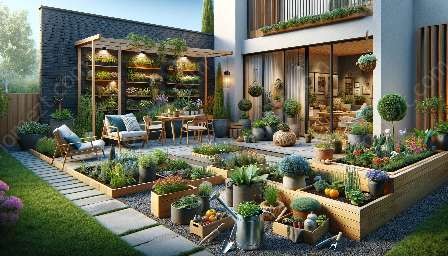Xeriscaping is a sustainable landscaping practice that focuses on water conservation while creating a beautiful outdoor space. This comprehensive guide will cover the principles, benefits, design, and maintenance of xeriscaping, as well as its compatibility with planting techniques and yard & patio.
The Principles of Xeriscaping
Xeriscaping is based on seven principles that help reduce water usage and maintenance while promoting environmental sustainability.
- Planning and Design: Xeriscaping involves careful planning and strategic design to maximize water efficiency and create a visually appealing landscape.
- Soil Improvement: Soil amendment techniques are used to improve water retention and reduce the need for frequent watering.
- Efficient Irrigation: Xeriscaping promotes the use of drip irrigation, rainwater harvesting, and smart irrigation systems to minimize water wastage.
- Appropriate Plant Selection: Drought-resistant, native, and low-water plants are chosen to thrive in xeriscaped gardens without excessive watering.
- Mulching: Mulching helps retain soil moisture, suppress weed growth, and improve the overall health of the landscape.
- Water-efficient Hardscaping: Patios, walkways, and other hardscape features are designed to minimize water runoff and maximize permeability.
- Maintenance: Xeriscaping requires minimal maintenance once established, reducing the need for frequent watering and pruning.
Benefits of Xeriscaping
Xeriscaping offers numerous benefits for homeowners and the environment.
- Water Conservation: By using efficient irrigation and drought-tolerant plants, xeriscaping reduces water consumption significantly, especially in arid regions.
- Low Maintenance: Once established, xeriscaped landscapes require minimal maintenance, saving time and effort for homeowners.
- Cost Savings: Reduced water usage and lower maintenance needs translate to lower utility bills and landscaping expenses.
- Environmental Sustainability: Xeriscaping promotes biodiversity, reduces chemical usage, and minimizes the environmental impact of traditional landscaping practices.
- Curb Appeal: Well-designed xeriscapes can enhance the appearance of a property and add value to the home.
Xeriscaping Design and Planning
When it comes to xeriscaping, careful planning and thoughtful design are essential for creating a sustainable and visually appealing landscape.
The following factors are considered in xeriscaping design:
- Site Analysis: Understanding the climate, soil conditions, and existing vegetation is crucial for selecting appropriate plants and designing an efficient irrigation system.
- Plant Selection: Drought-tolerant plants, native species, and low-water vegetation are chosen to create a resilient and water-efficient landscape.
- Hardscape Features: Patios, pathways, and other hardscaping elements are integrated into the design to minimize water usage and enhance outdoor living spaces.
- Integration of Water-efficient Techniques: Drip irrigation, rainwater harvesting, and permeable paving materials are utilized to reduce water consumption and promote sustainability.
Maintenance of Xeriscaped Landscapes
Proper maintenance is essential for preserving the beauty and functionality of xeriscaped landscapes.
The key maintenance tasks for xeriscaping include:
- Periodic Irrigation Adjustment: Regular monitoring of the irrigation system and adjustments to watering schedules are necessary to adapt to changing weather conditions.
- Pruning and Weeding: Occasional pruning and weeding help maintain the health and appearance of xeriscaped gardens while minimizing water usage.
- Mulch Renewal: Replenishing mulch layers helps retain soil moisture, suppresses weed growth, and improves the overall aesthetics of the landscape.
Xeriscaping and Planting Techniques
The principles of xeriscaping align with planting techniques that focus on water-efficient and sustainable gardening practices.
Planting techniques compatible with xeriscaping include:
- Water-efficient Irrigation: Drip irrigation, soaker hoses, and rainwater harvesting systems are used to deliver water directly to the plant roots, minimizing water wastage.
- Selection of Drought-tolerant Plants: By choosing plants adapted to arid conditions, xeriscaping and planting techniques harmonize to create resilient, low-maintenance landscapes.
- Soil Improvements: Techniques such as adding organic matter, compost, and mulch to the soil enhance water retention and promote healthy plant growth, aligning with xeriscaping principles.
Xeriscaping and Yard & Patio
Xeriscaping integrates seamlessly with yard and patio design, offering sustainable and aesthetically pleasing outdoor living spaces.
Key aspects of xeriscaping in yard and patio design include:
- Hardscape Materials: Permeable paving materials, such as permeable concrete or gravel, are used in yard and patio construction to minimize water runoff and promote groundwater recharge.
- Natural Landscaping Features: Drought-resistant plants, native species, and low-water vegetation enhance the beauty of yards and patios, complementing xeriscaping principles.
- Efficient Watering Solutions: Drip irrigation systems and rain barrels are incorporated into yard and patio design to minimize water usage and support xeriscape-friendly landscapes.
In conclusion, xeriscaping offers a sustainable, low-maintenance approach to landscaping that aligns with planting techniques and enhances yard and patio design. By following the principles of xeriscaping and incorporating water-efficient practices, homeowners can create beautiful, environmentally friendly outdoor spaces that require minimal resources and maintenance.



